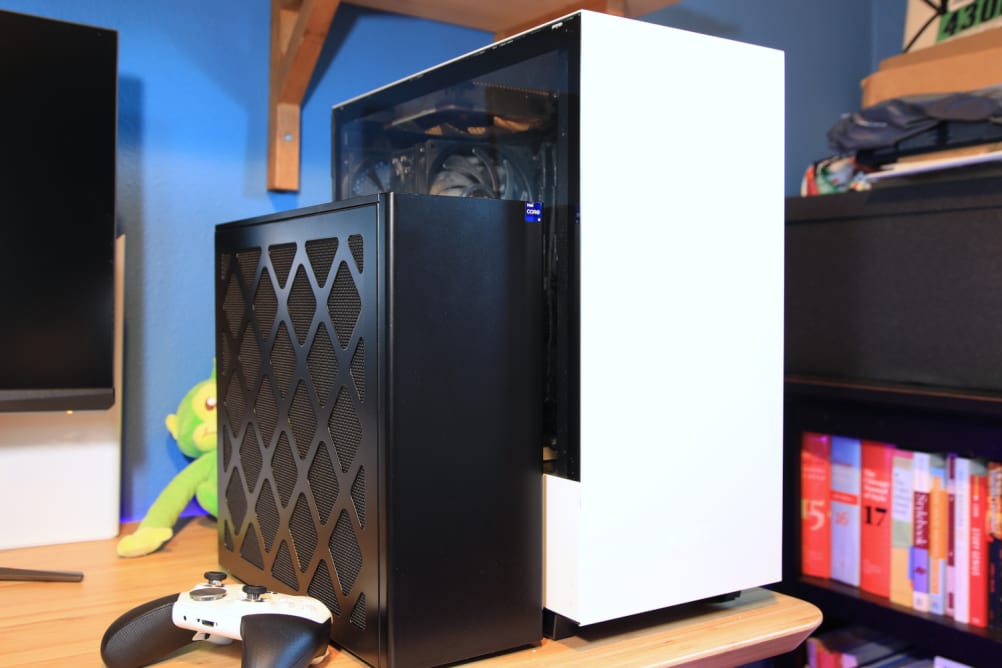Pros
-
Big PC performance in compact size
-
Great connectivity for its size
-
Excellent processor performance
Cons
-
Enclosure looks plain
-
Can be noisy
-
Not easy to upgrade
About the Intel NUC 13 Extreme Kit
Here are the specs of the desktop we tested:
- Processor: Intel Core i9-13900K
- Graphics: RTX 3080 Ti (tested, not included with kit)
- RAM: 32GB DDR5-4800 (tested, not included with kit)
- Storage: 1TB PCIe Gen4 solid state drive (tested, not included with kit)
- Wireless connectivity: Wi-Fi 6E, Bluetooth 5.2
- Wired connectivity: 2x Thunderbolt 4/USB-4, 6x USB-A 3.2 Gen 2, three-way analog audio, HDMI 2.1, 2x USB-A 3.1 (front), 3.5mm audio (front), USB-C (front)
- Weight: 15 pounds
- Size: 13.1 x 12.5 x 5.1 inches
There’s one key thing you must know about the Intel NUC 13 Extreme Kit: it’s a kit PC.
Intel sells the enclosure, the NUC 13 Extreme Compute Element (which includes the processor and motherboard), and the power supply as a bundle. The rest of the components in our test configuration were provided by Intel for testing but are not included with retail units.
Pricing starts at $1,179 for the entry-level model, which has an Intel NUC 13 Extreme Compute Element with an Intel Core i5-13600K processor. The version I tested, with the Intel Core i9-13900K processor, carries an MSRP of $1,549. That’s decent value for what’s included—but building out the kit could prove challenging.
What we like
It’s as small as it can be
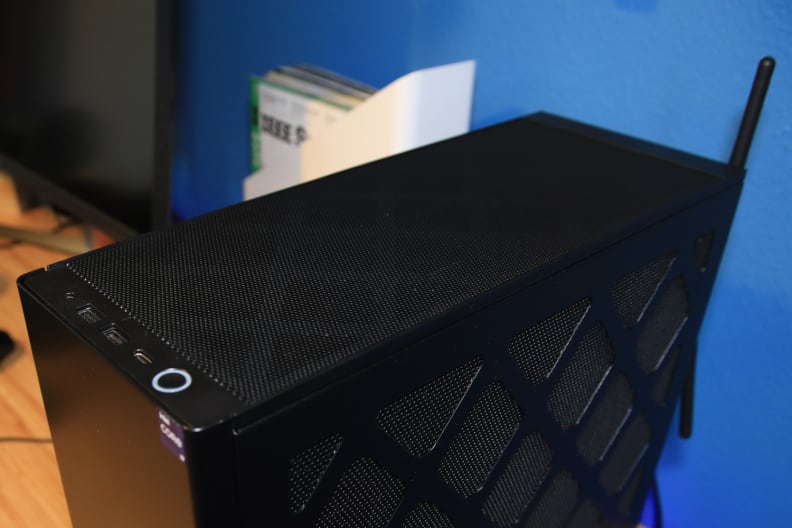
The NUC 13 is small enough to fit on a desk comfortably.
NUC is wedged between a rock and a hard place. Small, compact, user-serviceable design is the brand’s mission, but the increasing size and power draw of modern PC hardware has forced compromise. The first gaming-centric NUC was about the size of a Wii. The Intel NUC 13 Extreme is a bit larger than a PlayStation 4 Pro. Yet I can’t help but feel size remains a win for Intel.
Is it larger than before? Yes. But only as much as need be. A quick look at the hulking RTX 3080 Ti inside the Intel NUC Extreme 13 justifies the size. The card has just a few millimeters of clearance in all directions, leaving barely enough room to extract the card from the chassis. The NUC 13 Extreme could be smaller, but that would mean ditching support for the graphics cards enthusiasts want most.
The Intel NUC 13 Extreme’s total volume is about 14 liters, which rivals mainstream mini-ITX cases like the Lian Li 58Q. A few alternative enclosures, like the 12-liter Louqe Raw S1, are smaller but are typically priced at $250 or more for the enclosure alone.
Intel’s design strikes a unique profile at 13 inches tall and just five inches wide. Most small computers are a bit box-like because they need to fit a standard mini-ITX motherboard (which is 6.75 inches on a side). The NUC 13 Extreme instead has Intel’s unique and proprietary NUC 13 Extreme Compute Element, which has a rectangular footprint more like a PC graphics card. This difference in the shape of the internal hardware allows Intel to strike a more modern profile than most competitors.
Processor performance is outstanding
The Intel NUC 13 Extreme we received to test was the most powerful and expensive configuration with an Intel Core i9-13900K processor. We’ve already reviewed this desktop processor and found it to be a multi-core monster—and it still holds up when placed in a compact PC. The Intel NUC 13 Extreme is a processor performance beast that can muscle past most desktop computers sold in the past few years.
The Core i9-13900K processor achieved a Geekbench 5 single-core score of 2096 and a multi-core score of 21608. This processor scored 2250 and 24664 when reviewed in a larger desktop computer, so the NUC 13 Extreme’s compact size does inflict a penalty. However, these results remain remarkably strong when compared to older desktops. The Intel NUC 11 Extreme with Core i9-11900K, for example, scored only 1700 in Geekbench 5 single-core and 9442 in multi-core. That’s right: the new NUC 13 Extreme is twice as quick in the multi-core test.
It’s a similar story in Cinebench R23, where the Intel NUC 13 Extreme scored 2039 in single-core and 32497 in multi-core. This again falls slightly behind the Core i9-13900K tested in a full-sized desktop, which scored 2304 and 35948. However, the Intel NUC 13 Extreme blows the doors off older high-end systems. The NUC 11 Extreme scored only 11472 in Cinebench R23 multi-core, meaning the new NUC 13 Extreme is almost three times quicker in this benchmark!
As mentioned, the Intel NUC 13 Extreme is a kit computer, so it doesn’t come configured with RAM, storage, or graphics from the factory (though some specialty retailers, like SimplyNUC, will build the NUC 13 Extreme for you).
My test sample came fully equipped and ready to test, however, packing an Nvidia RTX 3080 Ti. It performed extremely well. Far Cry 6 averaged 88 frames per second (fps) at 4K resolution and Ultra detail, while Total War: Warhammer 3 averaged 99 fps at 1440p and Ultra settings. Even ray tracing was no problem; Control averaged 95 fps at 1080p, Ultra detail, and High ray tracing, and Cyberpunk 2077 averaged 64 fps at 1080p and Ultra ray tracing settings. Neither of our ray tracing tests used Nvidia DLSS.
Again, this is a kit computer, so the RTX 3080 Ti is not included. Still, these results show the NUC 13 Extreme is a very capable gaming platform.
There’s no shortage of ports
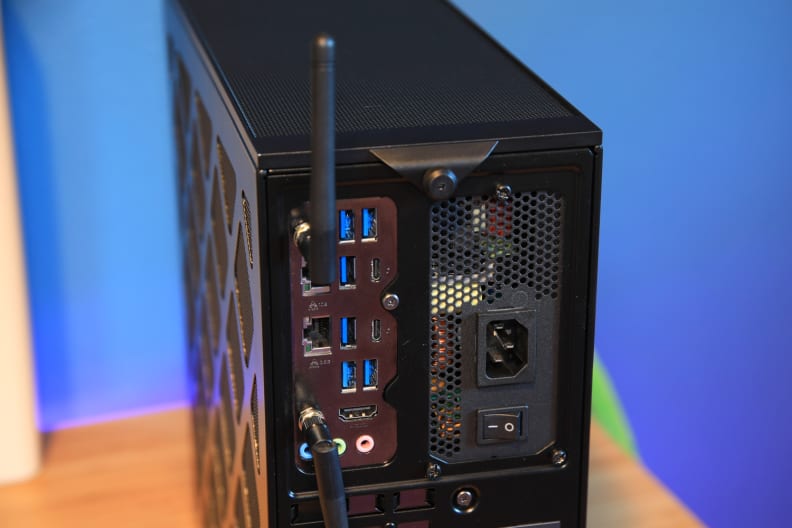
The NUC 13 offers lots of options for ports.
Small computers suffer a lackluster port selection, but the Intel NUC 13 Extreme is an exception. This is not only thanks to the number of available ports but also its support for the latest connectivity.
The rear panel ports include two Thunderbolt 4 / USB 4 ports, six USB-A 3.2 Gen 2, and three-way analog audio. This is an excellent range of rear panel connectivity at least on par with a mid-tower desktop. There’s also an Ethernet port with support for 2.5 Gigabit Ethernet (GbE) and 10GbE speeds.
Up front, there’s a pair of USB-A ports, plus one USB-C, and a 3.5mm audio jack. It’s good to see both USB-A and USB-C on the front panel. This is becoming common, but it’s still not universal regardless of the size of the PC desktop.
Video connectivity mostly depends on the graphics card installed in the kit. However, the Intel NUC 13 Compute Element has a single HDMI 2.1 output connected to the Intel Core i9-13900K’s integrated Intel UHD 770 graphics. I doubt it will see much use since you’ll have to connect the display cable to the graphics card’s HDMI port, but it’s available.
Wireless connectivity is great, too, with Wi-Fi 6E and Bluetooth 5.2. The Wi-Fi 6 E adapter with a 2x2 configuration and maximum speeds up to three gigabits per second (GB/s).
It’s expensive but competitive
The Intel NUC 13 Extreme Kit starts at an MSRP of $1,179 for the Intel Core i5-13600K model, while the top-tier Core i9-13900K model I tested is priced at an MSRP of $1,549. This, remember, doesn’t include RAM, storage, or a graphics card, none of which is included in the kit.
Building the Intel NUC 13 Extreme Kit to match the specifications of the test configuration, with 32GB DDR5-4800 memory, a 1TB PCIe Gen4 solid state drive, and RTX 3080 Ti graphics card (or similar), would put the total cost of the build between $2,800 and $3,000 at today’s prices.
Alternatively, SimplyNUC is taking pre-orders on prebuilt configurations expected to ship early next year. The retailer will sell a configuration similar to my test configuration for about $3,448, though with an RTX 3080 instead of RTX 3080 Ti.
These prices are high but in line with competitor systems. An Origin Chronos desktop gaming PC with Core i9-13900K, plus similar storage and memory, sells for a tad over $3,000 right now, though again with an RTX 3080 instead of RTX 3080 Ti. Digital Storm’s compact Bolt desktop retails for $3,372 with an AMD Ryzen 9 7900X and Nvidia GeForce RTX 3080.
No one will call the NUC 13 Extreme cheap, but the MSRP isn’t a big premium over other compact PCs.
What we don’t like
It’s ugly
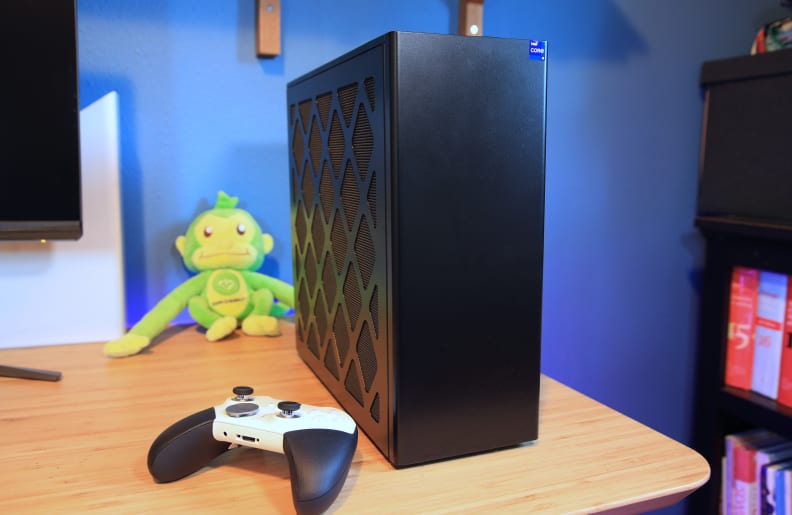
It's not the best looking case out there.
Intel’s past NUC Extreme devices have embraced brash, enthusiast branding with a skull logo usually backlit by LEDs that, in some models, could be customized in color.
The new NUC 13 Extreme ditches that style, opting for a look that’s anything but extreme. It’s a slab-sided monolith of metal and mesh. Nothing about the desktop stands out. Build quality is good, with no rough or sharp edges. The top panel is plastic, however, and feels a bit cheap compared to the rest of the chassis. Unfortunately, the top panel is the most frequent touch point, as it’s the starting point for opening the PC.
That’s a shame, because the market for small form factor PCs is awash in sleek, brilliant, and sometimes batty designs. The Lian Li 58Q offers style on a budget. The NZXT H210i successfully shrinks the tempered glass mid-tower look. The surprising G.Skill Z5i looks as likely to drift around your office as fire up Cinebench.
Whether this matters is a personal preference. I don’t put much stock in a desktop computer’s look, so the lack of zazz wouldn’t bother me. If you want a punched-up PC that looks the part, however, the NUC 13 Extreme isn’t going to cut it. I can’t help but feel that, given Intel’s size and engineering talent, a more eye-catching look should be possible.
It can be noisy
The Intel NUC 13 Extreme is barely large enough to contain its components, leaving little room for extra features—like sound deadening. Instead, the components are exposed on all sides, obscured only by metal and plastic mesh.
That’s bad news if you like a quiet computer. There’s nothing to stop the fan noise and coil whine from escaping. You’re treated to every whirr, blip, and squeal.
The real problem is not the volume but the quality of the noise. Modern video cards are prone to chatter, buzz, and squeal, like a flock of songbirds outside a window on a sunny spring morning. There’s nothing inside the NUC 13 Extreme to silence or dampen the noise.
Intel is not alone in this problem. Every small PC enclosure struggles with noise, and the smaller the enclosure, the more annoying it can be. This is worth considering if you’ve never purchased a small desktop before. The size is appealing, but the noise definitely isn’t.
Upgrades will be difficult
The Intel NUC 13 Extreme, like other NUC computers, is built to be as serviceable as possible within the constraints of its size. Most components can be upgraded, but there are limits.
First, here’s what can't be swapped for off-the-shelf components: the motherboard and the processor. These components are part of the Intel NUC 13 Extreme Compute Element, which is housed in the enclosure’s upper half. It’s possible to replace the Intel NUC 13 Extreme Compute Element with another NUC 13 Extreme Compute Element, but not the motherboard or processor individually. And, since the model I tested had the most powerful processor already, there’s no room to upgrade.
I’d argue this matters less than it seems. In theory, a standard motherboard allows for a processor upgrade. In practice, the processor sockets found on motherboards are frequently changed, so the ability to swap processors is only useful if you upgrade frequently. And if that’s true, well, a mid-tower PC is likely a better choice.
The NUC 13 Extreme has only two RAM slots and uses SODIMM modules (which are smaller in physical size, and common in laptops) instead of standard DIMM modules. Installing or swapping RAM is easy, as the RAM modules are immediately visible when the side panels are removed.
There’s a total of three M.2 slots and two SATA ports for storage. The drive bay can fit 2.5-inch drives, but only one 3.5-inch drive, so it’s best to stick to the smaller form factor. The drives are shielded by metal, which requires extra disassembly to get at them.
Triple-slot graphics cards up to 313mm long can fit inside the NUC 13’s graphics card bay. That covers a wide range of options but, you’ll want to pay close attention to the size of the card you’re installing. (Quad-slot graphics cards are no longer uncommon.) Swapping or installing the card requires serious disassembly of the case’s lower half and, when installing a large card, can be tricky due to the cramped interior. You’ll need special tools, like small screwdrivers and a plastic spudger, to get into those hard-to-reach places.
If this all sounds a bit technical—it is! Assembling a computer of this size isn’t rocket science, but it can be a challenge, and the price of the components could make it a nerve-wracking experience for many people. Intel at least provides a much-needed assembly manual with useful instructions.
Should you buy the Intel NUC 13 Extreme Kit?
Maybe, if you want ultimate performance in a small PC
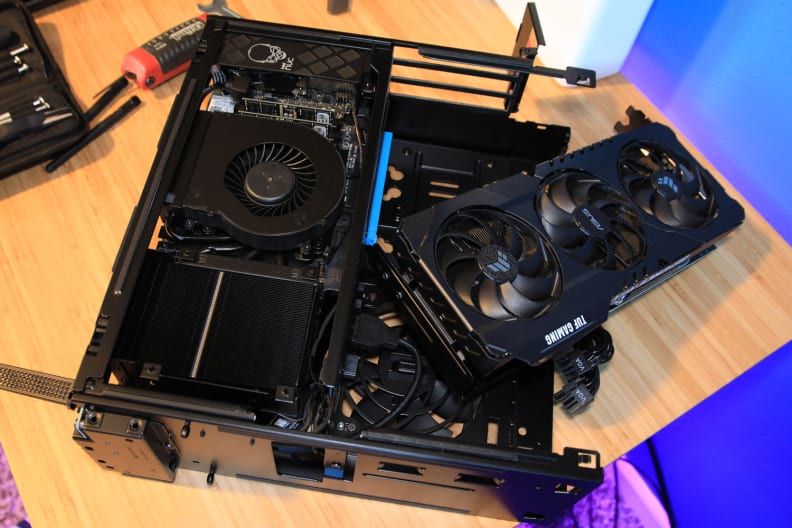
Upgrading may be a little bit difficult.
Intel’s NUC 13 Extreme Kit isn’t kidding around.
Despite its size, this desktop is a serious performer. The mighty Intel Core i9-13900K is absurdly fast, especially in multi-core tests, where its 24 cores chew through tasks, asking for more. The kit supports all but the largest graphics cards and up to three M.2 SSDs, making this powerhouse equally capable in games, content creation, and machine learning workloads.
Yet cramming this much hardware in a small enclosure inevitably requires sacrifices. Noise can be an issue, especially when the graphics card is at full load. It’s a kit PC, too, which means some assembly and sourcing of additional components is required. Component installation is unlike standard mid-tower desktops and could intimidate less experienced enthusiasts.
For most people, then, the NUC 13 Extreme is too extreme. If you believe less is more, however, give the NUC 13 Extreme a look. It’s extremely quick, supports many upgrades, and is priced competitively with compact desktops from boutique PC builders.
Meet the tester
Matthew S. Smith is a veteran tech journalist and general-purpose PC hardware nerd. Formerly the Lead Editor of Reviews at Digital Trends, he has over a decade of experience covering PC hardware. Matt often flies the virtual skies in Microsoft Flight Simulator and is on a quest to grow the perfect heirloom tomato.
Checking our work.
Our team is here to help you buy the best stuff and love what you own. Our writers, editors, and experts obsess over the products we cover to make sure you're confident and satisfied. Have a different opinion about something we recommend? Email us and we'll compare notes.
Shoot us an email